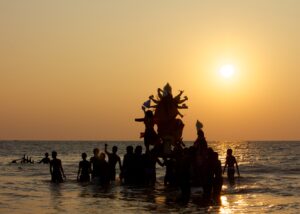Rosh Hashanah

Culture/religion: Judaism
Date: September 26-27
Rosh Hashanah (“Head of the Year”) is the birthday of the universe and the Jewish New Year. It is both a day of prayer and a day of joy when God is proclaimed King of the Universe.
The central observance of Rosh Hashanah is the sounding of the shofar (the ram’s horn) on both days of the holiday and takes place in the synagogue. The blowing of the shofar represents the trumpet at a king’s coronation.
Much of the day is spent in synagogue praying for God to grant all of His creations a sweet new year. Women and girls light candles on each evening of Rosh Hashanah and recite blessings, and festive meals are prepared and eat each night and day.
Rosh Hashanah begins at sundown September 25. No work permitted.
Pronunciation: ROHSH hah SHAH-nuh / RUSH-uh SHAH-nuh
Greetings:
- Before Rosh Hashanah
- For males: Leshanah tovah tikatev vetichatem; (May you be written and sealed for a good year)
- For females: Leshanah tovah tikatevee vetichatemee (May you be written and sealed for a good year)
- At noon on Rosh Hashanah until Yom Kippur
- Gemar chatimah tovah (A good final sealing)
Sources:
What is Rosh Hashanah?, Chabad.org
Glossary of Jewish Terminology, Judaism 101, jewfaq.org
International Deaf Awareness Week

Culture/religion: International observance
Date: September 26-30
International Week of the Deaf was started by the World Federation of the Deaf in 1958 in Rome, Italy. It is celebrated each year by the global Deaf community on the last week of September, commemorating the same month the first World Congress of the World Federation of the Deaf was held.
Sources:
International Week of the Deaf, World Federation of the Deaf
Navaratri

Culture/religion: Hindu
Date: September 26-October 4
Navaratri (“nine nights”) is a Hindu festival in honor of the divine feminine goddess, Durga. The festival is celebrated in autumn for nine nights and ten days. The legend of Navaratri tells of the victory of Durga over the demon king Mahishasura. Each day of the festival is dedicated to each of the nine forms of the goddess.
Navaratri is observed for different reasons and celebrated differently in various parts of India. During the festival, some devotees of Durga fast and pray for the protection of their health and property and wear different colors of clothing each day.
Sources:
Navaratri – All You Need to Know, Asia Highlights
Italian American Heritage Month

Culture/religion: National observance
Date: October
Italian American Heritage Month is celebrated to honor the achievements and contributions of Italian immigrants and their descendants living in the United States.
First celebrated in 1989, events are usually held to celebrate and educate the public about Italian American history.
Sources:
Italian-American Heritage and Culture Month, Wikipedia
LGBT History Month
Culture/religion: National observance
Date: October

LGBT History Month is a month-long annual observance of lesbian, gay, bisexual and transgender history, and the history of the gay rights and related civil rights movements. It is observed during October in the United States, to include National Coming Out Day on October 11. LGBT History Month originated in the United States and was first celebrated in 1994. It was founded by Missouri high-school history teacher Rodney Wilson.
Sources:
Disability Employment Awareness Month

Culture/religion: National observance
Date: October
National Disability Employment Awareness Month, recognized annually in October, is a national campaign through the Department of Labor’s Office of Disability Employment Policy. It began as an effort to raise awareness about disability employment issues and celebrates the many and varied contributions of America’s workers with disabilities.
Sources:
National Disability Employment Awareness Month, Department Of Labor’s Office of Disability Employment Policy

